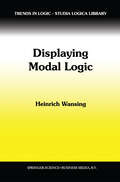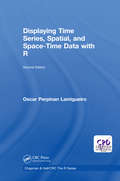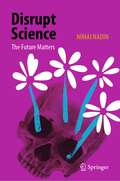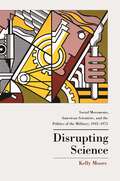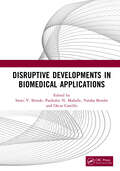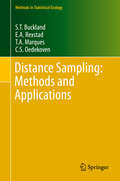- Table View
- List View
Displaying Modal Logic (Trends in Logic #3)
by Heinrich WansingThe present monograph is a slightly revised version of my Habilitations schrift Proof-theoretic Aspects of Intensional and Non-Classical Logics, successfully defended at Leipzig University, November 1997. It collects work on proof systems for modal and constructive logics I have done over the last few years. The main concern is display logic, a certain refinement of Gentzen's sequent calculus developed by Nuel D. Belnap. This book is far from offering a comprehensive presentation of generalized sequent systems for modal logics broadly conceived. The proof-theory of non-classical logics is a rapidly developing field, and even the generalizations of the ordinary notion of sequent listed in Chapter 1 can hardly be presented in great detail within a single volume. In addition to further investigating the various approaches toward generalized Gentzen systems, it is important to compare them and to discuss their relative advantages and disadvantages. An initial attempt at bringing together work on different kinds of proof systems for modal logics has been made in [188]. Another step in the same direction is [196]. Since Chapter 1 contains introductory considerations and, moreover, every remaining chapter begins with some surveying or summarizing remarks, in this preface I shall only emphasize a relation to philosophy that is important to me, register the sources of papers that have entered this book in some form or another, and acknowledge advice and support.
Displaying Time Series, Spatial, and Space-Time Data with R (Chapman & Hall/CRC The R Series)
by Oscar Perpinan LamigueiroFocusing on the exploration of data with visual methods, this book presents methods and R code for producing high-quality static graphics, interactive visualizations, and animations of time series, spatial, and space-time data. Practical examples using real-world datasets help you understand how to apply the methods and code. Each of the three parts of the book is devoted to different types of data. In each part, the chapters are grouped according to the various visualization methods or data characteristics. Recent developments in the "htmlwidgets" family of packages are covered in this second edition with many new interactive graphics.
Displaying Time Series, Spatial, and Space-Time Data with R (Chapman & Hall/CRC The R Series)
by Oscar Perpinan LamigueiroFocusing on the exploration of data with visual methods, this book presents methods and R code for producing high-quality static graphics, interactive visualizations, and animations of time series, spatial, and space-time data. Practical examples using real-world datasets help you understand how to apply the methods and code. Each of the three parts of the book is devoted to different types of data. In each part, the chapters are grouped according to the various visualization methods or data characteristics. Recent developments in the "htmlwidgets" family of packages are covered in this second edition with many new interactive graphics.
Disquisitiones Arithmeticae
by Carl Friedrich Gauss William C. WaterhouseCarl Friedrich Gauss’s textbook, Disquisitiones arithmeticae, published in 1801 (Latin), remains to this day a true masterpiece of mathematical examination. .
Disrupt Science: The Future Matters
by Mihai NadinReaction to breakdowns is more expensive, by many orders of magnitude, than prevention. This again became clear during the COVID-19 pandemic and is evinced in the sustainability crisis. The dynamics of living matter transcends deterministic reaction. Embodied in machines, determinism empowered the human being, providing the path to prosperity. However, in conjunction with reductionism, it does away with complexity, in which life is couched. The living is by necessity anticipatory. Awareness of the future means preserving life not in reaction to, but in anticipation of change. Living entities, from the simplest bacteria, to plants and insects, to human beings, are adaptive, goal-oriented, and capable of self-healing. Anticipatory actions are expressed through non-deterministic processes that unfold in concert with reactions. They engage the wholeness of life, including its interactions with the environment. Awareness of consequences, together with memory of the past, informs actions that reflect the creative nature of human beings. Redefining science—and implicitly, medicine—is not a negation of its past, but rather an affirmation of trust in explaining life’s capacity to renew itself. As opposed to increasingly expensive medicine as a practice of repair, to prevent and to heal is to make life sustainable. The moment of truth can no longer be postponed. At stake is the future of humankind and even of life on planet Earth. Reductionist determinism informs the obsession with progress at any cost. Awareness of the fact that the human condition transcends that of the matter in which it is embodied explains, and indeed justifies, the call to Disrupt Science in its current state. The age of the digital machine, in particular of artificial intelligence, is one of opportunities that pale when compared to its inherent risks. The record of breakdowns (including so-called natural disasters), by now global in scale, is part of the empirical premise for the call for completing the Cartesian Revolution. A “Second Revolution in Science” could unleash humanity’s remaking, free of surrendering to want. Science has the opportunity not only to measure everything—life included—and accumulate data and process it for its own sake, but also to realize its meaning. The book cover is designed by Baruch Gorkin, who is celebrated internationally for exquisite typefaces and for books reflecting meaning-driven design.
Disrupting Science: Social Movements, American Scientists, and the Politics of the Military, 1945-1975 (PDF)
by Kelly MooreIn the decades following World War II, American scientists were celebrated for their contributions to social and technological progress. They were also widely criticized for their increasingly close ties to military and governmental power--not only by outside activists but from among the ranks of scientists themselves. Disrupting Science tells the story of how scientists formed new protest organizations that democratized science and made its pursuit more transparent. The book explores how scientists weakened their own authority even as they invented new forms of political action. Drawing extensively from archival sources and in-depth interviews, Kelly Moore examines the features of American science that made it an attractive target for protesters in the early cold war and Vietnam eras, including scientists' work in military research and activities perceived as environmentally harmful. She describes the intellectual traditions that protesters drew from--liberalism, moral individualism, and the New Left--and traces the rise and influence of scientist-led protest organizations such as Science for the People and the Union of Concerned Scientists. Moore shows how scientist protest activities disrupted basic assumptions about science and the ways scientific knowledge should be produced, and recast scientists' relationships to political and military institutions. Disrupting Science reveals how the scientific community cumulatively worked to unbind its own scientific authority and change how science and scientists are perceived. In doing so, the book redefines our understanding of social movements and the power of insider-led protest.
Disrupting Science: Social Movements, American Scientists, and the Politics of the Military, 1945-1975 (Princeton Studies in Cultural Sociology)
by Kelly MooreIn the decades following World War II, American scientists were celebrated for their contributions to social and technological progress. They were also widely criticized for their increasingly close ties to military and governmental power--not only by outside activists but from among the ranks of scientists themselves. Disrupting Science tells the story of how scientists formed new protest organizations that democratized science and made its pursuit more transparent. The book explores how scientists weakened their own authority even as they invented new forms of political action. Drawing extensively from archival sources and in-depth interviews, Kelly Moore examines the features of American science that made it an attractive target for protesters in the early cold war and Vietnam eras, including scientists' work in military research and activities perceived as environmentally harmful. She describes the intellectual traditions that protesters drew from--liberalism, moral individualism, and the New Left--and traces the rise and influence of scientist-led protest organizations such as Science for the People and the Union of Concerned Scientists. Moore shows how scientist protest activities disrupted basic assumptions about science and the ways scientific knowledge should be produced, and recast scientists' relationships to political and military institutions. Disrupting Science reveals how the scientific community cumulatively worked to unbind its own scientific authority and change how science and scientists are perceived. In doing so, the book redefines our understanding of social movements and the power of insider-led protest.
Disruptive Developments in Biomedical Applications
by Swati V. Shinde Parikshit N. Mahalle Varsha Bendre Oscar CastilloThis book covers advancements and future challenges in biomedical application development using disruptive technologies like AI, IoT and signal processing. Book is divided into four main sections namely medical image processing using AI, IoT and biomedical devices, biomedical signal processing and electronic health records including advances in biomedical systems. It includes different case studies of biomedical applications using different AI algorithms related to diabetes, skin cancer, breast cancer, cervical cancer, osteoarthritis, and so forth. Features: Covers different technologies like AI, IOT and signal processing in the context of biomedical applications. Reviews medical image analysis, disease detection, and prediction. Comprehends the advantage of recent technologies for medical record keeping through electronics health records (EHRs). Presents state of art research in the field of biomedical engineering using various physiological signals. Explores different Bio Sensors used in Healthcare Applications using IOT. This book aims at Graduate students and researchers in artificial intelligence, medical imaging, biomedical engineering, and internet of things.
Disruptive Developments in Biomedical Applications
by Swati V. Shinde Parikshit N. Mahalle Varsha Bendre Oscar CastilloThis book covers advancements and future challenges in biomedical application development using disruptive technologies like AI, IoT and signal processing. Book is divided into four main sections namely medical image processing using AI, IoT and biomedical devices, biomedical signal processing and electronic health records including advances in biomedical systems. It includes different case studies of biomedical applications using different AI algorithms related to diabetes, skin cancer, breast cancer, cervical cancer, osteoarthritis, and so forth. Features: Covers different technologies like AI, IOT and signal processing in the context of biomedical applications. Reviews medical image analysis, disease detection, and prediction. Comprehends the advantage of recent technologies for medical record keeping through electronics health records (EHRs). Presents state of art research in the field of biomedical engineering using various physiological signals. Explores different Bio Sensors used in Healthcare Applications using IOT. This book aims at Graduate students and researchers in artificial intelligence, medical imaging, biomedical engineering, and internet of things.
Disruptive Technologies and Optimization Towards Industry 4.0 Logistics (Springer Optimization and Its Applications #214)
by Panos M. Pardalos Athanasia Karakitsiou Athanasios MigdalasThis contributed volume guides researchers and practitioners on resource collaborative management of supply chains and manufacturing enterprises within an industrial internet technological environment. The book comprises 10 chapters that cover two major topics in the subject of logistics 4.0, namely the utilization of both disruptive technologies and optimization techniques in smart logistic management. With global research on the book's topic expanding rapidly across various directions and disciplines, it provides a structured framework for international experts to showcase outstanding work and unique approaches. Researchers and students will find the comprehensive outline on collaborative optimization and management of smart manufacturing and production, warehousing, inventory, logistics, transportation, integrated supply chain, and supply network within the industrial internet platform a beneficial guide to understanding current and future practical problems that arise in manufacturing and supply chain management.
Dissemination of Information in Communication Networks: Broadcasting, Gossiping, Leader Election, and Fault-Tolerance (Texts in Theoretical Computer Science. An EATCS Series)
by Juraj Hromkovič Ralf Klasing A. Pelc Peter Ruzicka Walter UngerPresents the background and context of all ideas, concepts, algorithms, analyses and arguments before discussing details.Accessible to both beginners as well as specialists.
Dissipation and Control in Microscopic Nonequilibrium Systems (Springer Theses)
by Steven J. LargeThis thesis establishes a multifaceted extension of the deterministic control framework that has been a workhorse of nonequilibrium statistical mechanics, to stochastic, discrete, and autonomous control mechanisms. This facilitates the application of ideas from stochastic thermodynamics to the understanding of molecular machines in nanotechnology and in living things. It also gives a scale on which to evaluate the nonequilibrium energetic efficiency of molecular machines, guidelines for designing effective synthetic machines, and a perspective on the engineering principles that govern efficient microscopic energy transduction far from equilibrium. The thesis also documents the author’s design, analysis, and interpretation of the first experimental demonstration of the utility of this generally applicable method for designing energetically-efficient control in biomolecules. Protocols designed using this framework systematically reduced dissipation, when compared to naive protocols, in DNA hairpins across a wide range of experimental unfolding speeds and between sequences with wildly different physical characteristics.
Dissipative Exciton Dynamics in Light-Harvesting Complexes (BestMasters)
by Marco SchröterMarco Schröter investigates the influence of the local environment on the exciton dynamics within molecular aggregates, which build, e.g., the light-harvesting complexes of plants, bacteria or algae by means of the hierarchy equations of motion (HEOM) method. He addresses the following questions in detail: How can coherent oscillations within a system of coupled molecules be interpreted? What are the changes in the quantum dynamics of the system for increasing coupling strength between electronic and nuclear degrees of freedom? To what extent does decoherence govern the energy transfer properties of molecular aggregates?.
Dissipative Ordered Fluids: Theories for Liquid Crystals
by André M. Sonnet Epifanio G. VirgaThis is a book on the dissipative dynamics of ordered fluids, with a particular focus on liquid crystals. It covers a whole range of different theories, mainly concerned with nematic liquid crystals in both their chiral and nonchiral variants. The authors begin by giving a detailed account of the molecular origins of orientational order in fluids. They then go on to develop a general framework in which continuum theories for ordered fluids can be phrased. Within this unified setting, they cover both well-established classical theories and new ones with aspects that are not yet completely settled. The book treats a wide range of hydrodynamic theories for liquid crystals, from the original 1960s works by Ericksen and Leslie to new, fast-developing ideas of liquid crystal science. The final chapter is devoted to nematoacoustics and its applications. Old experiments on the propagation of ultrasound waves in nematic liquid crystals are interpreted and explained in the light of a new theory developed within the general theoretical infrastructure proposed in the body of the book. This book is intended both for graduate students and professional scholars in mathematics, physics, and engineering of advanced materials. It delivers a solid framework for liquid crystal hydrodynamics and shows the unifying concepts at the basis of the classical theories. It illustrates how these concepts can also be applied to a wide variety of modern topics. Andre M. Sonnet is in the Department of Mathematics and Statistics at the University of Strathclyde, Glasgow (Scotland) and Epifanio G. Virga is in the Department of Mathematics at the University of Pavia (Italy). They have a long history of working together in liquid crystal science and have contributed, in particular, to the theories of defects and biaxial nematics.
Dissipative Quantum Chaos and Decoherence (Springer Tracts in Modern Physics #172)
by Daniel BraunThis overview of the state of the art of research in an exciting field mainly emphasizes the development of a semiclassical formalism that allows one to incorporate the effect of dissipation and decoherence in a precise, yet tractable way into the quantum mechanics of classically chaotic systems.
Dissipative Solitons: From Optics to Biology and Medicine (Lecture Notes in Physics #751)
by Nail Akhmediev Adrian AnkiewiczThe dissipative soliton concept is a fundamental extension of the concept of solitons in conservative and integrable systems. It includes ideas from three major sources, namely standard soliton theory developed since the 1960s; nonlinear dynamics theory; and Prigogine's ideas of systems far from equilibrium. These three sources also correspond to the three component parts of this novel paradigm. This book explains the above principles in detail and gives the reader various examples.
Dissipative Solitons in Reaction Diffusion Systems: Mechanisms, Dynamics, Interaction (Springer Series in Synergetics #70)
by Andreas LiehrWhy writing a book about a specialized task of the large topic of complex systems? And who will read it? The answer is simple: The fascination for a didactically valuable point of view, the elegance of a closed concept and the lack of a comprehensive disquisition.The fascinating part is that field equations can have localized solutions exhibiting the typical characteristics of particles. Regarding the field equations this book focuses on, the field phenomenon of localized solutions can be described in the context of a particle formalism, which leads to a set of ordinary differential equations covering the time evolution of the position and the velocity of each particle. Moreover, starting from these particle dynamics and making the transition to many body systems, one considers typical phenomena of many body systems as shock waves and phase transitions, which themselves can be described as field phenomena. Such transitions between different level of modelling are well known from conservative systems, where localized solutions of quantum field theory lead to the mechanisms of elementary particle interaction and from this to field equations describing the properties of matter. However, in dissipative systems such transitions have not been considered yet, which is adjusted by the presented book. The elegance of a closed concept starts with the observation of self-organized current filaments in a semiconductor gas discharge system. These filaments move on random paths and exhibit certain particle features like scattering or the formation of bound states. Neither the reasons for the propagation of the filaments nor the laws of the interaction between the filaments can be registered by direct observations. Therefore a model is established, which is phenomenological in the first instance due to the complexity of the experimental system. This model allows to understand the existence of localized structures, their mechanisms of movement, and their interaction, at least, on a qualitative level. But this model is also the starting point for developing a data analysis method that enables the detection of movement and interaction mechanisms of the investigated localized solutions. The topic is rounded of by applying the data analysis to real experimental data and comparing the experimental observations to the predictions of the model.A comprehensive publication covering the interesting topic of localized solutions in reaction diffusion systems in its width and its relation to the well known phenomena of spirals and patterns does not yet exist, and this is the third reason for writing this book. Although the book focuses on a specific experimental system the model equations are as simple as possible so that the discussed methods should be adaptable to a large class of systems showing particle-like structures.Therefore, this book should attract not only the experienced scientist, who is interested in self-organization phenomena, but also the student, who would like to understand the investigation of a complex system on the basis of a continuous description.
Dissipative Structures and Chaos
by Hazime Mori Yoshiki KuramotoThis book consists of two parts, the first dealing with dissipative structures and the second with the structure and physics of chaos. The first part was written by Y. Kuramoto and the second part by H. Mori. Throughout the book, emphasis is laid on fundamental concepts and methods rather than applications, which are too numerous to be treated here. Typical physical examples, however, including nonlinear forced oscilla tors, chemical reactions with diffusion, and Benard convection in horizontal fluid layers, are discussed explicitly. Our consideration of dissipative structures is based on a phenomenolog ical reduction theory in which universal aspects of the phenomena under consideration are emphasized, while the theory of chaos is developed to treat transport phenomena, such as the mixing and diffusion of chaotic orbits, from the viewpoint of the geometrical phase space structure of chaos. The title of the original, Japanese version of the book is Sanitsu Kozo to Kaosu (Dissipative Structures and Chaos). It is part of the Iwanami Koza Gendai no Butsurigaku (Iwanami Series on Modern Physics). The first Japanese edition was published in March 1994 and the second in August 1997. We are pleased that this book has been translated into English and that it can now have an audience outside of Japan. We would like to express our gratitude to Glenn Paquette for his English translation, which has made this book more understandable than the original in many respects.
Dissipative Structures in Transport Processes and Combustion: Interdisciplinary Seminar, Bielefeld, July 17–21, 1989 (Springer Series in Synergetics #48)
by Dirk MeinköhnAny description of the workings of nature by means of measurements and ob servations is beset with the problem of how to cope with an immense amount of information. In physics, it is an established approach to derive basic equations which then serve as cornerstones of what is called a theory of the phenomena. This derivation is based on certain characteristics of the phenomena, the refine ment of which results from a reduction of the amount of empirical information, with the reduction leading to an enhancement of the very characteristics that are sought for in the otherwise seemingly amorphous wealth of data. If physics is mainly concerned with the derivation of equations, lately there has emerged a conceptually different approach, which in a way is equivalent to a reversal of the line of attack: here, the basic equations serve as the point of departure and the aim is to demonstrate that the equations are capable of de to represent the essence of the scribing certain characteristics which are thought phenomenon under investigation. By definition, this variant approach must tran scend the realm of pure physics and could possibly be termed "applied mathe matics" in a broader sense. The phenomena it strives to characterize arise from a range of influences such that a combination of theoretical concepts from physics, chemistry, engineering, biology, etc. , is called for.
Distance Expanding Random Mappings, Thermodynamical Formalism, Gibbs Measures and Fractal Geometry (Lecture Notes in Mathematics #2036)
by Volker Mayer Bartlomiej Skorulski Mariusz UrbanskiThe theory of random dynamical systems originated from stochasticdifferential equations. It is intended to provide a framework andtechniques to describe and analyze the evolution of dynamicalsystems when the input and output data are known only approximately, according to some probability distribution. The development of this field, in both the theory and applications, has gone in many directions. In this manuscript we introduce measurable expanding random dynamical systems, develop the thermodynamical formalism and establish, in particular, the exponential decay of correlations and analyticity of the expected pressure although the spectral gap property does not hold. This theory is then used to investigate fractal properties of conformal random systems. We prove a Bowen’s formula and develop the multifractal formalism of the Gibbs states. Depending on the behavior of the Birkhoff sums of the pressure function we arrive at a natural classification of the systems into two classes: quasi-deterministic systems, which share manyproperties of deterministic ones; and essentially random systems, which are rather generic and never bi-Lipschitz equivalent to deterministic systems. We show that in the essentially random case the Hausdorff measure vanishes, which refutes a conjecture by Bogenschutz and Ochs. Lastly, we present applications of our results to various specific conformal random systems and positively answer a question posed by Bruck and Buger concerning the Hausdorff dimension of quadratic random Julia sets.
Distance Geometry: Theory, Methods, and Applications
by Antonio Mucherino, Carlile Lavor, Leo Liberti and Nelson MaculanThis volume is a collection of research surveys on the Distance Geometry Problem (DGP) and its applications. It will be divided into three parts: Theory, Methods and Applications. Each part will contain at least one survey and several research papers. The first part, Theory, will deal with theoretical aspects of the DGP, including a new class of problems and the study of its complexities as well as the relation between DGP and other related topics, such as: distance matrix theory, Euclidean distance matrix completion problem, multispherical structure of distance matrices, distance geometry and geometric algebra, algebraic distance geometry theory, visualization of K-dimensional structures in the plane, graph rigidity, and theory of discretizable DGP: symmetry and complexity. The second part, Methods, will discuss mathematical and computational properties of methods developed to the problems considered in the first chapter including continuous methods (based on Gaussian and hyperbolic smoothing, difference of convex functions, semidefinite programming, branch-and-bound), discrete methods (based on branch-and-prune, geometric build-up, graph rigidity), and also heuristics methods (based on simulated annealing, genetic algorithms, tabu search, variable neighborhood search). Applications will comprise the third part and will consider applications of DGP to NMR structure calculation, rational drug design, molecular dynamics simulations, graph drawing and sensor network localization.This volume will be the first edited book on distance geometry and applications. The editors are in correspondence with the major contributors to the field of distance geometry, including important research centers in molecular biology such as Institut Pasteur in Paris.
Distance Learning, E-Learning and Blended Learning in Mathematics Education: International Trends in Research and Development (ICME-13 Monographs)
by Jason Silverman Veronica HoyosThis book builds on current and emerging research in distance learning, e-learning and blended learning. Specifically, it tests the boundaries of what is known by examining and discussing recent research and development in teaching and learning based on these modalities, with a focus on lifelong mathematics learning and teaching. The book is organized in four sections: The first section focuses on the incorporation of new technologies into mathematics classrooms through the construction or use of digital teaching and learning platforms. The second section presents a wide range of perspectives on the study and implementation of different tutoring systems and/or computer assisted math instruction. The third section presents four new innovations in mathematics learning and/or mathematics teacher education that involve the development of novel interfaces’ for communicating mathematical ideas and analyzing student thinking and student work. Finally, the fourth section presents the latest work on the construction and implementation of new MOOCs and rich media platforms developed to carry out specialized mathematics teacher education.
Distance-Regular Graphs (Ergebnisse der Mathematik und ihrer Grenzgebiete. 3. Folge / A Series of Modern Surveys in Mathematics #18)
by Andries E. Brouwer Arjeh M. Cohen Arnold NeumaierEver since the discovery of the five platonic solids in ancient times, the study of symmetry and regularity has been one of the most fascinating aspects of mathematics. Quite often the arithmetical regularity properties of an object imply its uniqueness and the existence of many symmetries. This interplay between regularity and symmetry properties of graphs is the theme of this book. Starting from very elementary regularity properties, the concept of a distance-regular graph arises naturally as a common setting for regular graphs which are extremal in one sense or another. Several other important regular combinatorial structures are then shown to be equivalent to special families of distance-regular graphs. Other subjects of more general interest, such as regularity and extremal properties in graphs, association schemes, representations of graphs in euclidean space, groups and geometries of Lie type, groups acting on graphs, and codes are covered independently. Many new results and proofs and more than 750 references increase the encyclopaedic value of this book.
Distance Sampling: Methods and Applications (Methods in Statistical Ecology)
by S. T. Buckland E.A. Rexstad T.A. Marques C.S. OedekovenIn this book, the authors cover the basic methods and advances within distance sampling that are most valuable to practitioners and in ecology more broadly. This is the fourth book dedicated to distance sampling. In the decade since the last book published, there have been a number of new developments. The intervening years have also shown which advances are of most use. This self-contained book covers topics from the previous publications, while also including recent developments in method, software and application.Distance sampling refers to a suite of methods, including line and point transect sampling, in which animal density or abundance is estimated from a sample of distances to detected individuals. The book illustrates these methods through case studies; data sets and computer code are supplied to readers through the book’s accompanying website. Some of the case studies use the software Distance, while others use R code. The book is in three parts. The first part addresses basic methods, the design of surveys, distance sampling experiments, field methods and data issues. The second part develops a range of modelling approaches for distance sampling data. The third part describes variations in the basic method; discusses special issues that arise when sampling different taxa (songbirds, seabirds, cetaceans, primates, ungulates, butterflies, and plants); considers advances to deal with failures of the key assumptions; and provides a check-list for those conducting surveys.
Distance, Symmetry, and Topology in Carbon Nanomaterials (Carbon Materials: Chemistry and Physics #9)
by Ali Reza Ashrafi Mircea V. DiudeaThis contributed volume is inspired by the seminal discovery and identification of C60. Starting with a comprehensive discussion featuring graphene based nanostructures, subsequent chapters include topological descriptions of matrices, polynomials and indices, and an extended analysis of the symmetry and topology of nanostructures. Carbon allotropes such as diamond and its connection to higher-dimensional spaces is explored along with important mathematical and topological considerations. Further topics covered include spontaneous symmetry breaking in graphene, polyhedral carbon structures, nanotube junction energetics, and cyclic polyines as relatives of nanotubes and fullerenes. This book is aimed at researchers active in the study of carbon materials science and technology.
